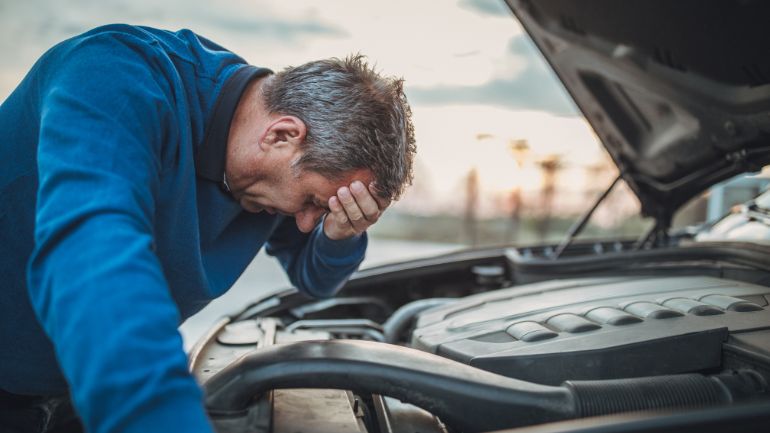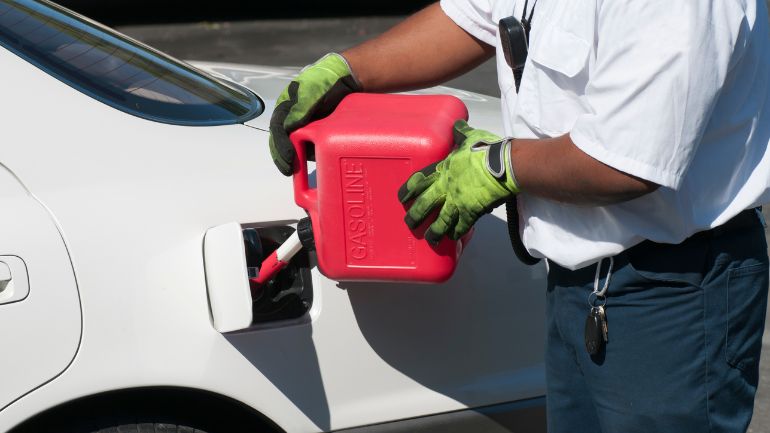Have you ever wanted to ruin a vehicle’s engine? The good news is that most people haven’t, and you shouldn’t. Nevertheless, there are ways to ruin a vehicle’s engine without evidence.
For instance, you could blow up the engine using chlorine or pour bleach into the gas tank. Nevertheless, you’d never want to do this because vehicles are so expensive.
Table of Contents
How to Destroy Your Engine in One Minute

The vehicle’s engine is its most important component, so you’ll want to do everything to protect it. Otherwise, you’re going to end up with an unusable car.
Still, it would be possible to destroy an engine in a matter of seconds. You could use the technique below to ruin a vehicle’s engine. How to ruin an engine without evidence? Find out below.
1. Pouring Stuff In The Gas Tank
The easiest and most discreet way to ruin a vehicle is by putting something in the gas tank. In general, only gasoline should be poured into the tank because anything else could severely damage the engine.
Any foreign material poses the risk of damaging the car. For instance, it would be possible to ruin the car by pouring sugar, water, or bleach into the tank. These chemicals could potentially cause the fuel filter to become clogged.
On the other hand, they may leak into the engine and cause irreparable engine damage. By using these chemicals, you could likely destroy the engine without leaving any evidence behind.
To protect your vehicle, remember only to put gasoline in your gas tank and always park in a well-lit area.
2. Adding Water To The Tank
Water is harmless until it enters the gas tank. Water is problematic because it will lead to compression issues and cause the piston rods to bend. Eventually, the excess bending will cause the rods to break.
Once this happens, the engine will likely be severely damaged too. Plus, water in the tank and engine will eventually cause rust. Even as little as a cup of water can ruin a vehicle.
If water has been poured into a car’s tank, white smoke will begin coming from the exhaust, the fuel efficiency will drop, and the car may not start.
Again, do not put water in your car’s gas tank because it will destroy the engine.
3. Putting Bleach In The Tank
Bleach may cause even more problems than water. If the chemical remains in the engine for an extended period, it will cause rust to develop.
It will also break down the metal and rubber components and decrease the engine’s efficiency. It is hard to know the exact impact without knowing how much bleach was added to the tank.
Nevertheless, you can guarantee that the damage is going to be severe.
4. Pouring Salt In A Gas Tank
Salt can also lead to major issues because it will eventually clog the filter. It may cause prevent the fuel pump from working properly.
Once the salt dissolves, it may cause corrosion to develop inside the tank. Salt won’t dissolve in gasoline, though. Salt is a problem on its own, but it is even riskier when mixed with water.
Therefore, adding salt and water to a gas tank is probably one of the most effective ways to destroy a vehicle’s engine.
5. Using Brake Fluid
Brake fluid should never be poured into a car’s gas tank because it will destroy the engine. Nevertheless, brake fluid isn’t as harmful as bleach or water.
DOT 5 fluid is worse because the fluid is silicone-based. Once it has been poured into the gas tank, it will likely damage the oxygen sensor.
It may be possible to offset this risk by adding more gas to the tank. Doing so will dilute the brake fluid and prevent it from damaging the sensor.
Of course, it is best never to pour brake fluid into your vehicle’s gas tank.
6. What About Sugar?
Sugar is not going to dissolve in gasoline, so it will get clogged in the fuel lines. Over time, this will clog other vital components of the fuel system and prevent the car from running.
Some newer vehicles have advanced fuel filters that can prevent sugar from getting into the engine, but there is no guarantee that the filter will work.
If the filter doesn’t stop the sugar, the injectors, pumps, and engine will become clogged.
The sugar build-up will harden and make the problem even worse. Once the sugar has entered the tank, you’re going to experience more frequent engine stalling, reduced engine performance, and difficulty starting the vehicle.
The fuel pump will also fail. It is illegal to put sugar or any foreign substance in someone’s gas tank, so don’t do it.
7. Urinating In The Gas Tank
Some people have thought about urinating in their gas tank when they’re out of gas. Others want to do it as a way to prank their friends.
This is a major mistake because the urine is going to seriously damage the vehicle’s important components. Urine will cause the gas filter to become plugged, causing the engine to shut down.
Urine can also make the engine run poorly. It can also lead to the development of rust.
8. Hydrogen Peroxide In A Gas Tank

Hydrogen peroxide is another chemical that should never be added to a vehicle’s gas tank. However, the results will vary depending on the concentration of the hydrogen peroxide.
A higher concentration will cause bigger problems much sooner. Regardless, you’re likely not going to be able to start your car with hydrogen peroxide in the tank.
The chemical will quickly sink to the floor of the tank and cause a buildup of oxygen. As a result, there is a serious risk of explosion.
9. Pouring Soda In The Tank
Coke and other soda can be poured into the gas tank in small quantities without harming any components. However, too much soda can harm the engine and other components.
The engine will not be able to process large amounts since these drinks contain a lot of water. The water may enter the fuel pump and fuel lines.
The engine won’t be able to start since it can’t use water for this purpose. Another issue is the fact that the soda contains sugar.
To resolve the problem, you’ll need to replace your filters and hope the engine is still okay.
10. Baking Soda In Cars
Using baking soda is another way to potentially destroy a car’s engine. Besides destroying the engine, the baking soda will also damage the catalytic converter.
If this happens, the engine’s performance will be hindered, and the vehicle will release higher emissions. Still, baking soda isn’t considered as harmful as bleach and sugar.
Biggest Things To Avoid When Destroying A Engine
Certain chemicals should never be added to a vehicle’s engine because doing so could be incredibly dangerous.
For instance, certain substances are flammable, so they could cause an explosion when the car is started.
Lighter fluid, paint thinner, kerosene, and other flammable liquids fit into this category. Do not put these chemicals in the gas tank because the results could be deadly.
What Are The Repercussions?
If you’re serious about damaging a car’s engine, you should be ready for the possible repercussions.
What you’re doing is a serious crime because you’re destroying someone’s property.
Using sugar or another substance to destroy a car is illegal. Depending on certain circumstances, you may be facing misdemeanor or felony charges.
Furthermore, you’ll likely encounter a lawsuit from the vehicle’s owner since they’ll want you to pay for the replacement. Unless you’re happy to go to jail, don’t tamper with anyone’s vehicle.
You’ll also have to worry about the foreign substance in the gas tank causing an explosion. It could kill someone, and you could be charged with murder.
It is best to keep your hands to yourself.
Cost To Replace A Car Engine
If a car’s engine is damaged, the replacement cost is going to be very expensive. If you’re held responsible, you’ll have to cover the cost.
For a four-cylinder engine, you will spend as much as $4,000 to fix the problem. In some cases, the price can be even higher.
You’ll also have to worry about damage to other parts of the vehicle. If you add sugar to the tank, the sugar may also damage the fuel pump, filters, and lines.
In all likelihood, all of these components will need to be replaced before the vehicle will start and run again.
It might be cheaper and easier to replace the vehicle with a new one. The price of replacing a high-performance engine can be as high as $10,000, so think twice before putting sugar in your gas tank.
How To Maintain Your Car’s Engine
While some people may be adamant about destroying the engine in their cars, routine maintenance is a priority for others.
There is no doubt it is easier to damage a motor than to keep one well-maintained. Whatever the case may be, a replacement could easily break the bank.
Every owner should have a vehicle maintenance checklist. Car maintenance should not be limited to the engine but all internal major components:
- Rack and pinion steering
- Battery
- Electronic Control Unit “ECU” (computer)
- Exhaust system
- Fuel system
- Tires
- Transmission
- Brakes
- Radiator
- AC compressor
- Alternator
- Suspension system
- Fuel and water pumps
- Filters and fluids
Each system plays a major role in the functionality and performance of a vehicle. Since an aftermarket engine and transmission tend to be the most expensive components, they are generally the targets of every maintenance scheme.
Routine Motor Oil Check
Every motorist should know the ins and outs of their vehicle’s engine. This knowledge will prove valuable for maintenance and repair purposes. Knowing the precise engine oil capacity.
Too much or too little motor oil can compromise the integrity of the engine. The average motor oil capacity for standard passenger cars is five quarters, give or take little.
The automotive dashboard or control panel is a vital tool, especially for inexperienced drivers. The design features a variety of icons, all of which have a significant purpose.
For example, the oil can icon represents a low fluid level. The solution is a quick oil level check. Pull out the dipstick, wipe it clean, and replace it completely in the tube before reading the measurement.
Routine Coolant Fluid Check
The coolant system plays a significant role in keeping an engine from overheating.
A liquid coolant, antifreeze, continuously flows through the system to maintain between 195 and 220 degrees Fahrenheit. Anything over 220 degrees Fahrenheit puts significant strain on the engine.
Overheating is detrimental to an engine. If the engine does not immediately shut down, the high temperatures will cause serious damage.
In severe instances, overheating will warm or bend the pistons and/or cylinder walls, blow the head gasket, and ruin the engine block.
How to destroy your engine in one minute? Let it overheat.
Preventing Gas Tank Tampering
You can take steps to prevent people from tampering with your gas tank. One of the best ways to do that is by using a locking gas cap.
The cap must be removed using a key. Since you’ll have the key, nobody else will be able to access your gas tank.
It is also important to park in your garage or in a well-lit area. Make sure your vehicle’s security system is working properly.
Park around security cameras. Unfortunately, there is no way to stop all criminals.
Still, following these tips may stop someone from putting sugar in your gas tank.
Frequently Asked Question
Is It Illegal To Put Sugar In A Gas Tank?
It is illegal to pour sugar into someone’s gas tank. You’re tampering with their property and potentially destroying it. Depending on the circumstances, you may face felony charges, and you may have to pay for the damages.
Will Ethanol Harm A Vehicle’s Engine?
Ethanol has been added to gasoline for many years, but it can still damage parts of your vehicle. Usually, ethanol is fine unless the concentration is 10% or higher. Then, it will begin damaging your gas tank, gaskets, fuel pump, and other components.
What Is A Locking Gas Cap?
If you’re worried about someone tampering with your gas tank, consider buying a locking gas cap. The cap locks and will not open without a key. Therefore, no one can open your gas tank except for you.

Robert Bacon is a car nerd and automotive lover who has dedicated his life to understanding the inner workings of vehicles. He holds a degree in mechanical engineering and has spent years working as a mechanic and engineer for some of the world’s top car companies. In his spare time, he enjoys writing about cars on this blog and tinkering with his 2016 Toyota Mirai in his garage.